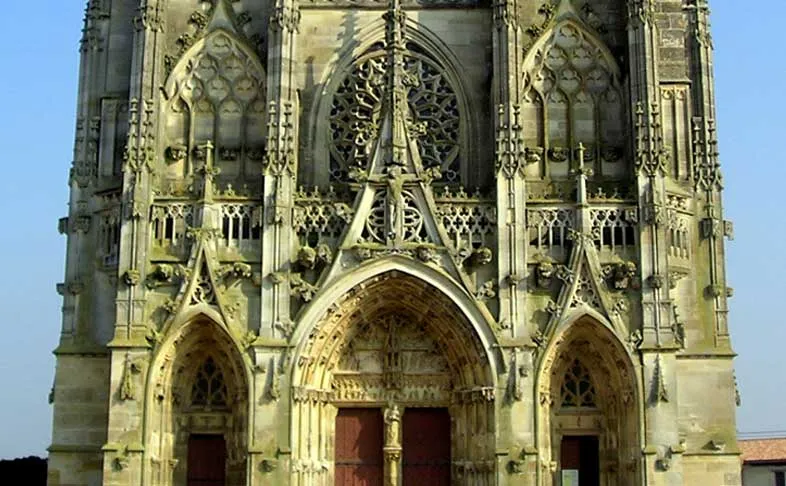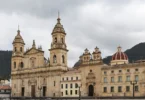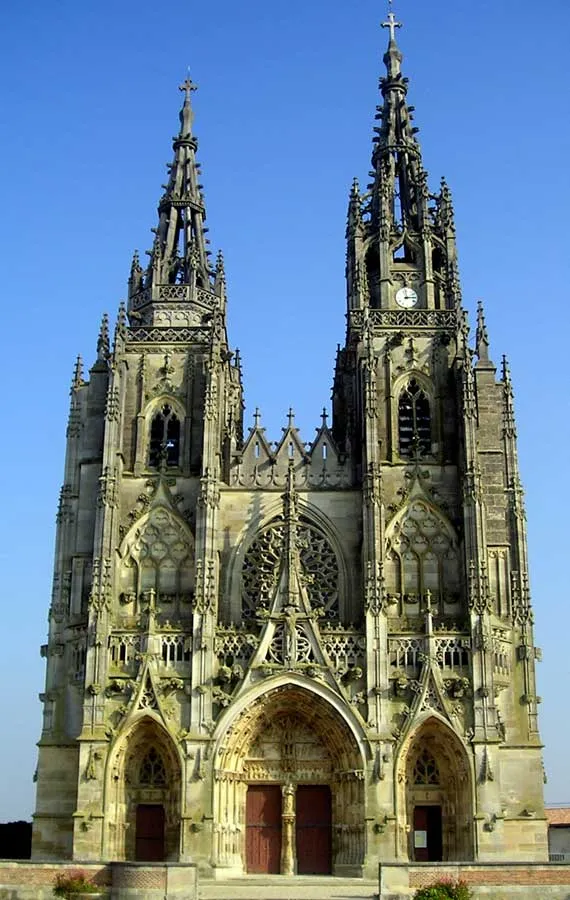
Introduction
The Basilica of Our Lady of l’Épine (French: Basilique Notre-Dame de l’Épine) is a Roman Catholic basilica in the small village of L’Épine, Marne, near Châlons-en-Champagne and Verdun. It is a major masterpiece in the Flamboyant Gothic style.
Started around 1405 construction lasted until 1527. Elevated to a basilica from 1914, Notre-Dame-de-l’Épine takes its name from the devotion given to a statue of the Virgin holding the Child Jesus. According to a legend from the 17th century that has since evolved, the statue was found by shepherds in the Middle Ages in a burning thorn bush.
The basilica has the dimensions of a cathedral and is in the Gothic architectural tradition. The façade has three portals and is crowned with two spires. The right spire is 55 metres (180 ft) high. The left spire was leveled in 1798 to allow the installation of a Claude Chappe telegraph. It was rebuilt in 1868.
The basilica was classified a historic monument in 1840. In 1998 it was registered on the World Heritage List by UNESCO under the title of “roads to St Jacques de Compostela in France”. Notre-Dame de l’Épine has always struck travelers and inspired writers, especially Victor Hugo, Alexandre Dumas, Joris-Karl Huysmans, Paul Claudel and Paul Fort.
History of Basilique Notre-Dame de l'Épine, France
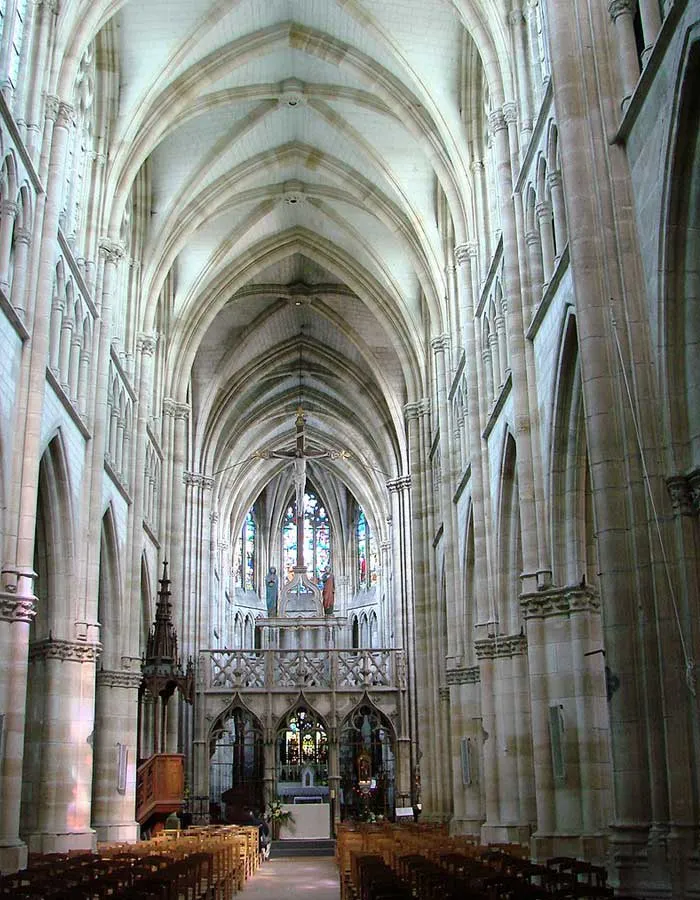
The village of L’Épine was built up gradually at the end of the Middle Ages around the building, which was originally just a humble chapel. It is the hamlet of Melette, in the commune of L’Épine, which was the seat of the former parish. Excavations have revealed the presence of a church there from the Merovingian period (7th century). This church dedicated to Saint-Léger depended on the abbey of Saint-Jean de Laon.
The site of the church of L’Épine was probably on the border between the territories of Melette and Courtisols. Places called “L’épine” are not rare in Champagne-Ardenne. These are most often isolated places, far from the villages. Thorn hedges were used in the High Middle Ages to mark the boundaries between properties.
This is a possible origin of the place name L’Épine: an old locality marking the boundary between two parishes. However, in L’Épine, the name is also charged with a strong religious value, since the motif of the thorn bush is associated with the Virgin Mary in the Middle Ages.
The Sainte-Marie de L’Épine church, mentioned for the first time around 1200, was probably only a modest rural chapel serving a few dwellings established near it or further down in the direction of the Vesle, in particular at the old place called Chevy or Chivette (which gave rise to the current rue de Chivette).
But suddenly at the beginning of the 15th century, the inhabitants embarked on an ambitious reconstruction project. It is a lawsuit which in 1404 to 1406 makes known to us the cause of this sudden effervescence: one evokes the existence of a pilgrimage to the Virgin Mary which one describes as immemorial. At the same time, we see that the legacies to “Sainte-Marie de L’Épine” or “Sainte-Marie de Courtisols” are more numerous in the wills.
Times were then particularly difficult, Châlons and its surroundings having suffered greatly from the Hundred Years War and plagues such as the plague. The pilgrims were above all people from the surrounding area and from Châlons, but from the beginning of the 15th century we also met people from Lorraine.
L’Épine, for the Châlonnais, has somewhat become an urban church outside the walls towards which the liveliest rays of urban piety have flowed. The inhabitants of L’Épine and Courtisols jointly administered the parish goods in the institution known as the fabrique. They are the ones who planned the current building to respond to the influx of pilgrims and thanks to the many offerings.
The site described as started in 1406 ended in 1527 or shortly after, for the structural work. It undoubtedly knew many stops and modifications. We know the name of the mason from Châlons Etienne Pontoise, working on the church in 1431, who abandoned the site and whose property was seized by the factory.
In 1455, Blavet Nérault would have worked on the site and would be responsible for the introduction of the flamboyant style: he probably laid the foundations of the facade without it being easy to trace the chronology of the construction of this piece of bravery. The completion of the building by the choir and the radiating chapels is better known. After a first campaign where Regny Goureau intervened, from 1509, the completion was entrusted in 1515 to Guichart Antoine and Antoine de Bertaucourt.
In the sixteenth century, after steps in progress from Rome, the inhabitants obtained the transfer of the seat of the parish of Melette to L’Épine, by bull of Pope Calixte III in 1458. This institutional change undoubtedly sanctioned the evolution marked by the progressive abandonment of the village of Melette and the group of inhabitants around the new church.
Architecture
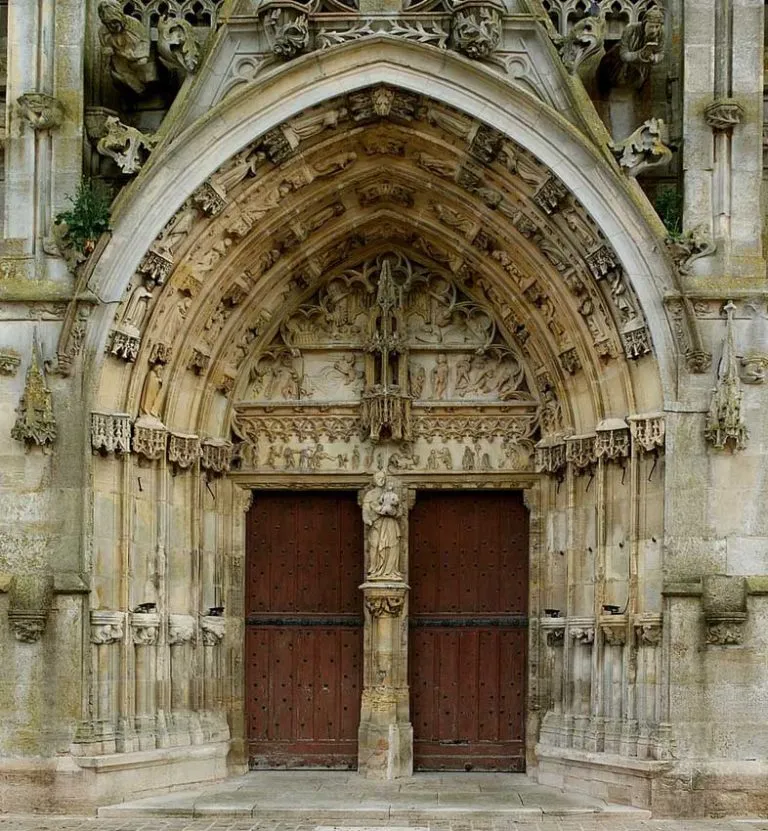
The basilica has remarkable gargoyles. Inside is a rood screen of the late 15th century, whose right arcade houses the statue of the Virgin for which this basilica is famous.
Statues include the Venerated Virgin (about 1300), seated virgin (15th century) and St. Jacques in wood (17th century). The altars from 1542, and the triumph crucifix from the 16th century. The tribune and organ case are 16th century. The tribune is decorated with eight apostles and seven pagan gods (inscriptions added in 1825 by Father Brisson). The choir organ is from Merklin. Stained glass is from the 19th and 20th centuries, mainly manufactured by the Champigneulle house.
The sources agree in attributing to lay people most of the initiatives concerning the construction site and undoubtedly the supervision of the pilgrimage. Nevertheless, the priests serving the church had obviously a role whose specificities are less known.
Some had obtained L’Épine only as a source of income, the masses being said by vicars or chaplains. We also know of an important lawsuit between the inhabitants of Courtisols and L’Épine and the priest Jacques de la Vieilville who wanted to capture the offering of 1,200 gold crowns made by King Louis XI, an offering that the inhabitants had very quickly injected into the expenses of the site.
A place of Marian prayer since the 13th century, elevated to the rank of basilica in 1914, the Basilica of the Thorn has been listed since 1998 as a UNESCO World Heritage Site under the Ways of Saint Jacques de Compostela.
On May 14, 2023, the 150th anniversary of the diocesan pilgrimage of Chalons to Notre-Dame de l’Epine, “protector of Champagne”, will be celebrated there.
Notre-Dame de l’ Epine (Our Lady of the Thorn)
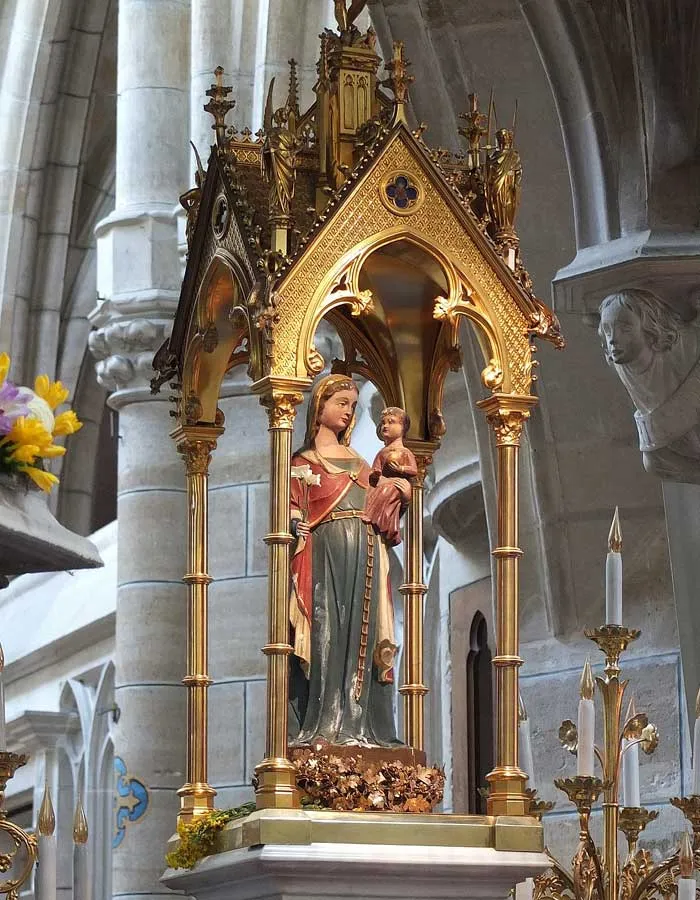
On the night of the Feast of the Annunciation, 24 March in the year 1400, some shepherds tending their flocks were attracted by a bright light coming from the Chapel of Saint John the Baptist near Chalons, France. As they approached the light, they saw that it was actually a thorn bush fully engulfed in flames and they discovered a statue of the Blessed Virgin standing unharmed in the midst of the flames. In fact, though the fire burned brightly, the branches and leaves of the thorn bush were unaffected by the flames.
The miracle continued all that night and into the next day and news of the miracle spread quickly. Most of the people crowded around the burning bush that was so reminiscent of the one witnessed by Moses on Mount Horeb. The Bishop of Chalons, Charles of Poiters, also witnessed the burning bush and the miraculous statue – both still unaffected by the fire.
When the flames finally did die down, the bishop reverently took the statue and carried it in his own hands to the nearby Chapel of Saint John. On the very site of the miracle, construction of a Church was begun for the enshrinement of the miraculous statue. Since the Church was built so rapidly – in a little over 24 years – a charming local legend claims that angels continued the work at night after the labourers had left for home.
Our Lady of the Thorn (Notre Dame de l’ Epine) became a place of pilgrimage very rapidly. Today, a minor Basilica, the Shrine proved to be so beautiful that the people considered it a worthy place to venerate the Blessed Virgin. The flamboyant Gothic church boasts majestic great doors, a splendid rosette decorating the principle entrance and two chiselled stone spires, rise high and imposing on the plain in Champagne.
During the terrible French Revolution, the statue of Our Lady of Thorns was removed from the main altar and hidden for safekeeping. After it had ended, the statue was brought back out for veneration.
Many miracles have also been reported at the Shrine, many verified by physicians. The beautiful Basilica of Our Lady of the Thorn has been recognised by several Popes, including Pope Calixtis III, Pius II and Gregory XV. Pope Leo XIII ordered the solemn coronation of the miraculous statue, saying, “Yes, Our Lady of the Thorn will be crowned in my name. Prepare for her a diadem worthy of the Mother of God and the people whom she protects…”
It is a place of grandeur where Christian souls can expand in adoration of the Son of God and many are the pilgrims of all descriptions, who have visited the Shrine over the years, including Saint Joan of Arc in 1429.
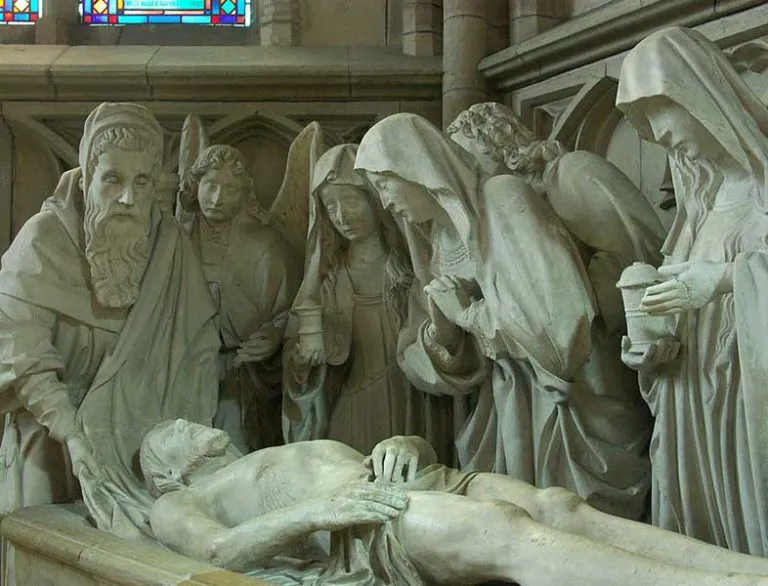
Mary at the Burning Bush
The specificity of the history of Notre-Dame de l’Epine lies not so much in the symbol of the thorn or hawthorn , Marian flower in the Middle Ages , as in other sanctuaries: N otre -Dame de l’Epine Thorn in Evron (Mayenne), Our Lady of Roncier in Josselin (Morbihan), the Virgin of Espino (Spain), Our Lady of the Thorn in Berlens (Switzerland), only in the theme of the bush. This invites a rapprochement with the revelation to Moses, uncommon at the time in the West.
Since the 4th century, the liturgy of January 1 (in the East as in the West) associates the image of the Burning Bush contemplated by Moses with the virginal maternity of the Virgin Mary. From the 12th century, the canons of the abbey of Saint Victor in Paris composed hymns associating Mary with the metaphor of the Bush of Moses by bringing her closer to the other metaphor, that of the “lily between the thorns”.
In the 12th century, iconography began to associate the Virgin with the bush by juxtaposing them. The representation of Mary on the burning bush is rarer:
In the East, on the icons that spread from Saint Catherine of Sinai (where tradition placed the location of the Burning Bush. (The trip to Sinai, associated with the pilgrimage to the Holy Land, was in full swing at the end of the Middle Ages Gilles Paixel, who offered a relic of the Holy Milk of the Virgin to L’Epine in 1406, was returning.)
In the West: the altarpiece commissioned for the cathedral of Aix-en-Provence by King René of Anjou around 1470.
Stained Glass Windows
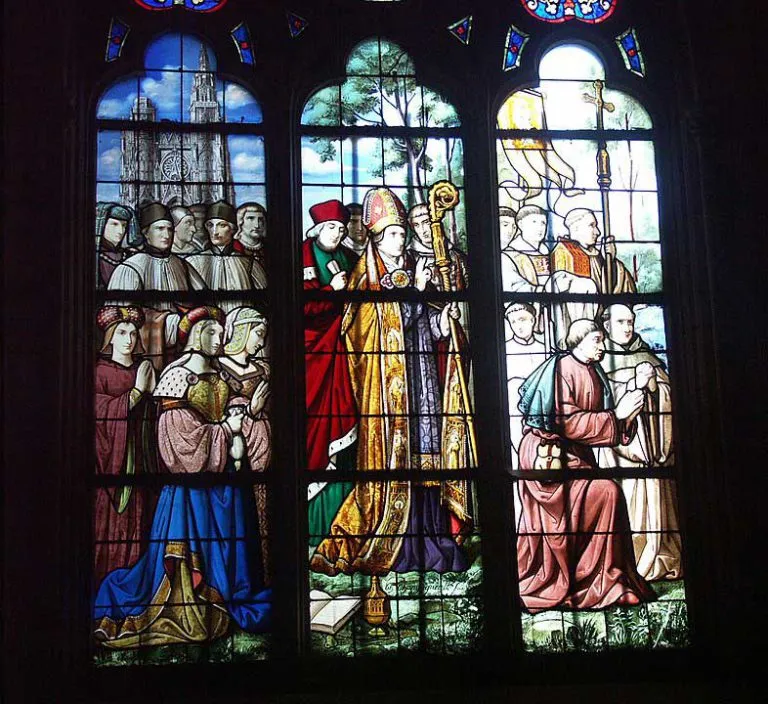
In the church of l’Epine: the stained glass window of the axial chapel, from the 15th century until around 1840, represented the Virgin Mary sitting as if on a throne in a hawthorn bush with foliage of light, overhung by a luminous star, and surrounded by sheep and lambs, and adoring shepherds. Was it the representation of the discovery of the miraculous statue by the shepherds, or the representation of the Burning Bush serving as a throne for the Virgin and Child, with Moses the shepherd taking off his shoes, as on the altarpiece of Aix?
The elements described in this stained glass window have been preserved in the current stained glass window of the chapel of Saint John the Baptist, with the details of the owl (symbol of the people of the first covenant awaiting the Messiah: “the people who walked in darkness saw a great light arise” and of the star (antiphon of the lauds of the solemnity of Mary Mother of God: “The stem of Jesse blossomed, a star came out of Jacob, the Virgin brought forth the Saviour. We praise thee, O our God.”
Stained glass window of the basilica in the chapel of Saint John the Baptist, made according to the description of the stained glass window of the axial chapel, from the 15th century, accidentally destroyed in the 19th century.
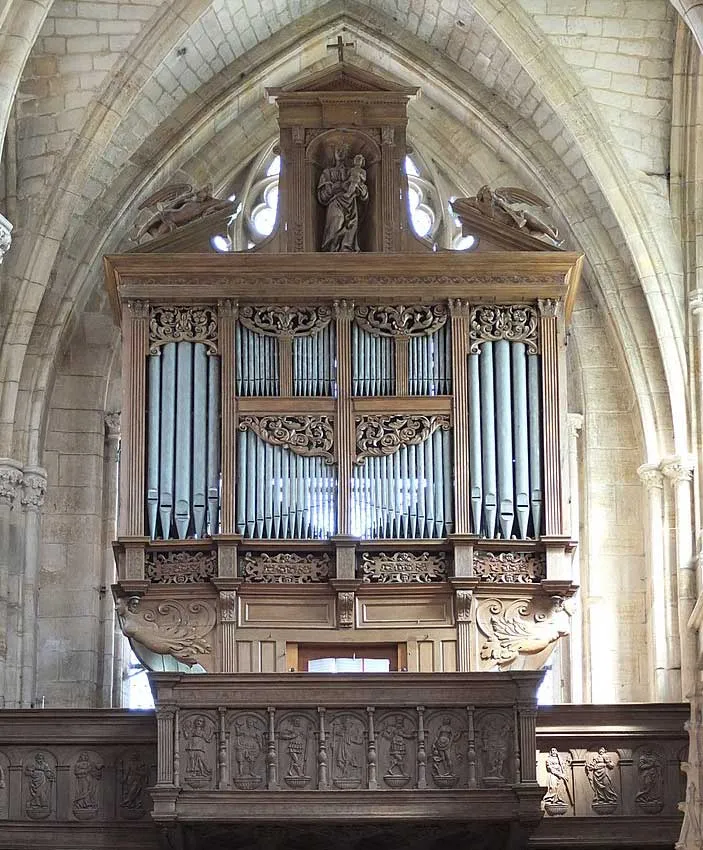
Feast Day - 24th March
Annual Feast Day of Our Lady of Thorn held on 24th March.
Mass Time
Mondays
Weekdays
Sundays
Church Visiting Time
- Mondays : 9:00 am to 7:00 pm
- Weekdays : 7:15 am to 9:15 pm
- Sundays : 7:45 am to 8:45 pm
Contact Info
1 Rue Emile Barbier,
51460 L’Épine, France.
Phone No.
Tel : +33 7 57 40 28 08
Accommodations
How to reach the Basilica
Châlons Vatry Airport also known as Paris-Vatry Airport is a minor international airport serving Châlons-en-Champagne in northeastern France is the nearby Airport to the Basilica.
Gare de Châlons-en-Champagne Transit Station in Châlons-en-Champagne, France is the nearby Railway Station to the Basilica.

